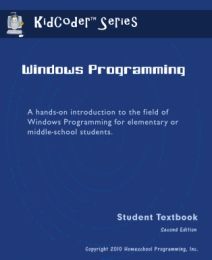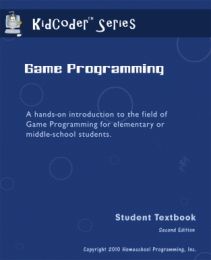I really don't know ANYTHING about computer programming, but I do KNOW that in this day and age my children need to be smarter than their mom. Steve Jobs said "Everyone in this country should learn how to program a computer . . . because it teaches you how to think." I definitely want my children to be great thinkers -- and I want to make sure that I'm staying on top of my thinking game as well. Homeschool Programming offers a series of programming courses that your children [or you] can use to write computer programs, games, and even Android applications. They are quick to tell you that each of their courses are self-study and there is no need for teacher expertise. Whew. That definitely makes me breathe a sigh of relief.
When the opportunity to review one of the programming courses from Homeschool Programming arose, I wasn't sure where we should begin. They offer courses designed specifically for both kids and teens -- and they are written for 4th - 12th graders (KidCoder) and 9th - 12th graders (TeenCoder). We fell into both of these age ranges so . . . After studying over the website myself and looking through sample pages of all the available courses, I asked our resident computer expert, my MainMost, to weigh in and give us his opinion on what we should pick to review. You know, he's the Director of Technology at the college and my favorite IT guy around, so I trust his opinion. This is what he said:
Pick the KidCoder Visual Basic Series -- it's a good starting place where the kids can learn the core concepts of programming and then extend those ideas into the more difficult languages.
So, based on expert advice from my hubby, I chose the KidCoder Visual Basic Series computer science course for Long Leaf Academy and once downloaded, I set about working through the first semester of work. Yes, you read that correctly. I began working through the programming course my very own self to see just how easy it would be to implement with my 7th and 9th graders when school starts back in August. And boy am I glad I did.
My computer is fairly new and easily meets the basic requirements (Windows computer with CD-ROM) to run the program. The KidCoder Visual Basic Series course is a hands-on class taught on your local computer. Other software/hardware requirements are:
- A CPU of at least 1.6Ghz
- At least 1024MB of RAM
- A display monitor with 1024 x 768 or higher resolution
- A graphics card supporting DirectX-10 or later
- A 5400+ RPM hard drive with 3GB or more free space
- A DVD-ROM Drive

 The KidCoder Visual Basic Series is a two semester course written specifically for students in 6th -8th grades. The first semester portion of the course is Windows Programming ($70 - $85 depending on the purchase of optional video supplements) and the second semester portion of the course is Game Programming ($70 - $85 depending on the purchase of optional video supplements). Please note that you MUST complete the first semester course before you begin the second semester course. You can also purchase the discounted KidCoder Visual Basic Year Pack which contains BOTH semesters of programming for $120 - $145 (again, depending on the purchase of the optional instructional videos). Each lesson can be completed without the use of the short instructional videos, but they have proven to be quite valuable to me as they help summarize the reading from each Chapter and add visual and auditory learning appeal.
The KidCoder Visual Basic Series is a two semester course written specifically for students in 6th -8th grades. The first semester portion of the course is Windows Programming ($70 - $85 depending on the purchase of optional video supplements) and the second semester portion of the course is Game Programming ($70 - $85 depending on the purchase of optional video supplements). Please note that you MUST complete the first semester course before you begin the second semester course. You can also purchase the discounted KidCoder Visual Basic Year Pack which contains BOTH semesters of programming for $120 - $145 (again, depending on the purchase of the optional instructional videos). Each lesson can be completed without the use of the short instructional videos, but they have proven to be quite valuable to me as they help summarize the reading from each Chapter and add visual and auditory learning appeal.Before beginning the Visual Basic Windows Programming course to learn the basics of writing their own computer programs, students should be familiar with the basic operation of a computer and be able to use the keyboard and mouse to run programs and should also know how to work with files and browse Windows Explorer. For most children, this is not a big deal -- they've been using computers from almost the time they were old enough to walk -- and mine are no exception. I know my way around the computer pretty well, too.
Divided into 14 Chapters that begin with a history of computers (to make sure the student knows exactly WHAT a computer is), students can easily complete one chapter a week. Each chapter is broken into 3 - 5 relatively short lessons (30 minutes to an hour a day). (The Table of Contents allows you to see the breakdown of Chapters and Lessons.) Students learn about different operating systems and learn how to install the Microsoft Visual Basic 2010 Express software needed to write computer programs in a step-by-step approach.
At the completion of each chapter's lessons, there is a Chapter Review for students to read that helps them remember the main points before completing a "Your Turn" hands-on activity. {From the very beginning, you are actively involved in writing code -- how cool is that?} Chapter Tests are included (10 multiple-choice questions each) with answers AND a complete Solution Guide is available for the "Your Turn" activities. Thank goodness for the Solution Guide -- it has been my saving grace. The Solution Guide contains screens shots to emulate and the exact source code you or your student should have written. (You can see for yourself in this sample and see how easy it will be to teach the Visual Basic programming language in your home.)
The topics covered the first semester of Visual Basic are as follows:
- Introduction to Computers
- Get Your Feet Wet (introduces Visual Basic and its development environment)
- Exploring Visual Basic Programs (graphical elements and syntax)
- Data Types and Variables
- Basic Flow Control (the "If" Statement)
- Getting User Input (Input Boxes)
- Working with Numbers (using math)
- Working with Strings
- Using the Debugger
- Loops in Programs
- Functions
- Arrays and Structures
- Distributing Your Programs
- Putting It All Together (creating a game of your own)
Now, I have not finished the first semester of Visual Basic yet -- I'm a MUCH SLOWER learner than my children -- but when I do reach the end I will have created a game of my very own. My Boy Scout says that this is the very best part. He's a gamer for sure and is most looking forward to the Game Programming portion of the course. (So much so that he didn't mind getting started with the Windows Programming portion early.) Of course, he's finding the daily lessons to be much easier than his momma --and that doesn't bother me at all.
Building on the Visual Basic Programming skills learned in Windows Programming, Game Programming is set up in much the same way as the first course so students simply pick up where they left off. The 14 Chapters each have 3 - 6 lessons followed by a "Your Turn" hands-on activity. At the completion of each chapter's work, a Chapter Test can be given. Solutions/answers are provided for all.
Students begin the Game Programming course by learning about the different game types available and then begin creating simple games of their own. Starting with basic components of game design and advancing into graphics, animation, and sound, students write game code for each chapter with the final game project a culmination of all lessons. As you can imagine, we can't wait to get to that part of the course.
Homeschool Programming is VERY teacher-friendly. Each programming course in the KidCoder Visual Basic Series comes with a self-study Student Textbook and a detailed Solution Guide. The instructional videos are optional, but we have enjoyed using them. I think you'll be quite impressed with what your students will learn.

I was given the opportunity to use and review KidCoder Visual Basic Series by Homeschool Programming as a member of the Schoolhouse Review Crew. You can check out the Crew Review and see what other members of the Schoolhouse Review Crew thought of this and other products as well (or just click on the banner below.)



No comments:
Post a Comment
Thanks for stopping by and sharing your heart with me!